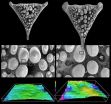(Press-News.org) New research from the University of Adelaide could help protect one of the world's most globally threatened tree species - the big leaf mahogany - from extinction.
Big leaf mahogany (Swietenia macrophylla) is the most prized mahogany timber around the world. It is at risk of extinction in its native habitats because of the timber trade, particularly in Central and South America.
To better understand how such a threatened species can be brought back from the brink of extinction, scientists from the University of Adelaide's Environment Institute have studied the important role played by the trees' pollen in the health and re-growth of mahogany forests.
The results of this study have been published online in Ecology Letters.
The researchers found that the extensive exploitation of mahogany forests has had a major impact on the diversity and availability of the trees' pollen. This in turn limits the ability of individual trees to grow and provide cross-fertilization for other mahogany trees.
"We collected data across seven Central American countries* which shows that trees remaining in cleared forest areas suffer from too much self-fertilization and low pollen diversity," says lead author Martin Breed, a PhD student with the University of Adelaide's Environment Institute and the School of Earth & Environmental Sciences.
"This results in less competitive seedlings and affects the rate of re-growth of the species."
Mr Breed says to restore forests would require replanting key species and finding good-quality seeds from healthy trees. "Growing new mahogany trees has proven a major challenge in the past. By better understanding the importance of pollen diversity, we hope this research provides the key to restoring forests at a much higher rate.
"Ensuring seed is collected from healthy populations will improve our chances of protecting not only mahogany, but the hundreds of other species - and human communities - that rely on it," he says.
Senior co-author Professor Andrew Lowe, Director of the Australian Centre for Evolutionary Biology and Biodiversity at the University of Adelaide, says: "Aside from being one of the world's most prized timbers, every mahogany tree provides habitat for hundreds of animals and plants, so they're ecologically very important."
He says this discovery has the potential to impact the way we think about restoring forests and shows us why it is vital to protect areas of high conservation value.
"Preserving areas where large populations of species have existed for the longest time not only assures the future of these iconic sites, but also provides insurance for entire species beyond the sites themselves," Professor Lowe says.
The project was largely funded from the European Union through the project SEEDSOURCE, with a portion of the funding coming from a grant awarded by the Australian Research Council.
Dr Carlos Navarro, who was employed by CATIE (the Tropical Agricultural Research and Higher Education Center) in Costa Rica at the time, was primarily responsible for directing the fieldwork and the collection of leaf and seed material used in the analysis and was the researcher who did the growth assessments.
INFORMATION:
* the seven countries are: Mexico, Guatemala, Belize, Honduras, Nicaragua, Costa Rica and Panama
END
Plants breathe through stomata
Plant leaves are protected from drying out by an airtight wax layer. They breathe and release water through microscopic pores called stomata. Every year 40% of atmospheric CO2 and twice the volume of water found in our atmosphere pass through these pores. This means that stomata are not only important for plant development but also for our climate!
It's no surprise then that these pores appear to be strictly regulated by plants. Stomata react extremely fast to internal plant signals and changes in the environment. When rain is scarce, ...
What effect does a TV advert have on a viewer? How does it bring about a change in their knowledge, emotions or intentions? These questions have existed alongside advertising ever since it began. Through a psycho-physiological study developed jointly by El Bureau de la Comunicación, the Tecnalia Centre for Applied Research, and the UPV/EHU, it has been possible to measure the emotional response of a person to a series of television adverts.
The aim of the study, carried out for the first time entirely in the Basque Autonomous Community (region), was to shed some light ...
Kaposi's sarcoma herpesvirus (KSHV) is a human tumor virus and an etiological agent for Kaposi's sarcoma and primary effusion lymphoma (PEL). PELs are aggressive lymphomas with reported median survival time shorter than six months after diagnosis.
Researchers at the University of Helsinki discovered that spontaneous induction of KSHV lytic replication in tumors drastically attenuated the p53-dependent apoptotic response not only to a targeted therapy (Nutlin-3) but also to genotoxic anti-cancer agents.
The findings by the research groups of Päivi Ojala (Institute of ...
Oesophageal cancer is a very serious form of cancer that, if not fatal, requires extensive surgery. A new study from Karolinska Institutet in Sweden shows that when serious complications arise after surgery for oesophageal cancer, many patients suffer other health problems, such as breathlessness, fatigue, insomnia and eating problems, for five years afterwards.
"Patients who suffer serious post-operative complications after surgery for oesophageal cancer need very close, long-term monitoring so that any problems that arise can be identified and targeted quickly," says ...
Despite the predicted environmental benefits of biofuels, converting land to grow bioenergy crops may harm native wildlife. Researchers at the Helmholtz Centre for Environmental Research in Leipzig have developed a way to study the effects of increased energy crop cultivation on farmland bird populations.
"The Skylark is an indicator species for agricultural areas because it occupies many habitats of the wider countryside around the globe, breeds on the ground within fields and feeds mostly on insects" notes lead researcher, Jan Engel. "Improving the habitat suitability ...
Neutrophil granulocytes comprise important defences for the immune system. When pathogenic bacteria penetrate the body, they are the first on the scene to mobilise other immune cells via signal molecules, thereby containing the risk. To this end, they release serine proteases – enzymes that cut up other proteins to activate signal molecules. Scientists at the Max Planck Institute of Neurobiology in Martinsried have now discovered a new serine protease: neutrophil serine protease 4, or NSP4. This enzyme could provide a new target for the treatment of diseases that involve ...
A new study has estimated that over 260,000 cats and dogs entered the care of UK rescue organisations during 2009, the first full year since the onset of the UK recession.
The aim of the research was to estimate the number of cats and dogs, currently being cared for by UK welfare organisations, the proportion of time that these organisations were full to capacity and the number entering these organisations during a 12-month period. The University of Bristol study by Dr Corinna Clark and colleagues in the School of Veterinary Sciences is published in the Veterinary ...
The journal Computers in Biology and Medicine has published an article on the new IT application BootstRatio, created by IDIBELL researchers. The application allows online statistical analysis of data from gene expression. It is accessible through http://regstattools.net/br and any scientist is already to use it.
Researchers at the Human Molecular Genetics group at IDIBELL, led by Dr. Virginia Nunes, had a problem to provide signification to the results of statistical analyses of gene expression data. Most of the statistical calculations which are done to compare gene ...
You are what you eat is truism that has been given new impetus by 'cutting edge' research led by the University of Leicester that reveals your teeth are literally shaped by your food.
Indeed, evidence from teeth can be used to determine what has been eaten by an animal providing a new way of working out the diets of wild animals that doesn't involve the unpleasant task of looking at the contents of their guts.
Scientists say it is also possible to use these methods to investigate diets of extinct animals such as giant marine reptiles and dinosaurs.
Research led by ...
Negative thinking is a red flag for clinical depression. Stopping such thoughts early on can save millions of people from mental illness, according research study from the Frances Payne Bolton School of Nursing at Case Western Reserve University.
Jaclene Zauszniewski, the Kate Hanna Harvey Professor in Community Health Nursing and associate dean for doctoral education at the school, has developed a brief 8-item survey to help healthcare providers identify depressive thinking patterns that may lead to serious depression if not identified and addressed early.
Zauszniewski's ...


